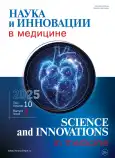Преимущества брыжеечного доступа к панкреатодуоденальной резекции при раке головки поджелудочной железы с инвазией магистральных сосудов
- Авторы: Абгарян М.Г.1, Котельников А.Г.1, Поляков А.Н.1, Авдюхин И.Г.1, Егенов О.А.1, Сунь Х.1, Стилиди И.С.1
-
Учреждения:
- ФГБУ «Национальный медицинский исследовательский центр онкологии имени Н.Н. Блохина» Минздрава России
- Выпуск: Том 10, № 3 (2025)
- Страницы: 232-236
- Раздел: Онкология, лучевая терапия
- URL: https://journal-vniispk.ru/2500-1388/article/view/312154
- DOI: https://doi.org/10.35693/SIM687668
- ID: 312154
Цитировать
Аннотация
Цель – сравнить стандартный и брыжеечный доступы к хирургическому лечению больных раком головки поджелудочной железы, инвазирующим воротную и/или верхнюю брыжеечную вены, и оценить их преимущества.
Материал и методы. Проведено хирургическое лечение 192 больных раком головки поджелудочной железы с инвазией воротной и/или верхней брыжеечной вены. В 43 (22,4%) случаях панкреатодуоденальную резекцию выполнили через брыжеечный доступ, у остальных 149 (77,3%) пациентов использовали стандартный подход к хирургическому лечению.
Результаты. Медиана длительности операций с брыжеечным доступом составила 290 мин., со стандартным – 300 мин., медиана кровопотери – соответственно 1120 мл и 1800 мл, р=0,0002. Статистически значимых различий отдаленных результатов лечения при брыжеечном и стандартном доступах не выявлено: прогрессирование аденокарциномы головки поджелудочной железы диагностировано соответственно у 48,8% и 49%, медиана общей выживаемости составила 24,5 мес. и 22,3 мес., медиана выживаемости без прогрессирования – 21,3 мес. и 22,1 мес. соответственно. Анализ отдаленных результатов лечения в зависимости от вида доступа и степени радикальности хирургического вмешательства показал, что частота развития местного рецидива при стандартном доступе у нерадикально оперированных больных достоверно выше (40,6% vs 7,7%, р=0,001).
Заключение. Преимущества брыжеечного доступа перед стандартным подходом к хирургическому лечению больных раком головки поджелудочной железы с инвазией воротной и/или верхней брыжеечной вены заключаются в следующем: 1) дает возможность оценить распространенность и операбельность опухоли уже в начале хирургического вмешательства; 2) обеспечивает достоверно более высокую частоту выполнения операций в объеме R0; 3) обеспечивает достоверно меньшую кровопотерю во время операции; 4) после циркулярной резекции магистральных вен дает больше возможностей выполнить пластику «конец в конец», что снижает риск развития тромбоза за счет формирования только одного анастомоза и уменьшает время пережатия магистральных вен, уменьшая риск ишемии печени и кишечника.
Полный текст
Открыть статью на сайте журналаОб авторах
М. Г. Абгарян
ФГБУ «Национальный медицинский исследовательский центр онкологии имени Н.Н. Блохина» Минздрава России
Email: abgaryan.mikael@gmail.com
ORCID iD: 0000-0001-8893-1894
канд. мед. наук, старший научный сотрудник, врач-онколог отделения абдоминальной онкологии №1 НИИ Клинической онкологии имени академика РАН и РАМН Н.Н. Трапезникова
Россия, МоскваА. Г. Котельников
ФГБУ «Национальный медицинский исследовательский центр онкологии имени Н.Н. Блохина» Минздрава России
Email: kotelnikovag@mail.ru
ORCID iD: 0000-0002-2811-0549
д-р мед. наук, ведущий научный сотрудник отделения абдоминальной онкологии №2 (опухолей гепатопанкреатобилиарной зоны) НИИ Клинической онкологии имени академика РАН и РАМН Н.Н. Трапезникова
Россия, МоскваА. Н. Поляков
ФГБУ «Национальный медицинский исследовательский центр онкологии имени Н.Н. Блохина» Минздрава России
Email: dr.alexp@gmail.com
ORCID iD: 0000-0001-5348-5011
канд. мед. наук, старший научный сотрудник отделения абдоминальной онкологии №2 (опухолей гепатопанкреатобилиарной зоны) НИИ Клинической онкологии имени академика РАН и РАМН Н.Н. Трапезникова
Россия, МоскваИ. Г. Авдюхин
ФГБУ «Национальный медицинский исследовательский центр онкологии имени Н.Н. Блохина» Минздрава России
Email: ivan.avdyukhin@yandex.ru
ORCID iD: 0000-0002-3524-1037
врач-онколог отделения абдоминальной онкологии №1 НИИ Клинической онкологии имени академика РАН и РАМН Н.Н. Трапезникова
Россия, МоскваОмар Алиевич Егенов
ФГБУ «Национальный медицинский исследовательский центр онкологии имени Н.Н. Блохина» Минздрава России
Автор, ответственный за переписку.
Email: egenov.omar@mail.ru
ORCID iD: 0000-0002-8681-7905
канд. мед. наук, врач-онколог отделения абдоминальной онкологии №2 (опухолей гепатопанкреатобилиарной зоны) НИИ Клинической онкологии имени академика РАН и РАМН Н.Н. Трапезникова
Россия, МоскваХэнянь Сунь
ФГБУ «Национальный медицинский исследовательский центр онкологии имени Н.Н. Блохина» Минздрава России
Email: sunalaric@gmail.com
ORCID iD: 0000-0001-5574-0047
врач-онколог отделения абдоминальной онкологии №1 НИИ Клинической онкологии имени академика РАН и РАМН Н.Н. Трапезникова
Россия, МоскваИ. С. Стилиди
ФГБУ «Национальный медицинский исследовательский центр онкологии имени Н.Н. Блохина» Минздрава России
Email: biochimia@yandex.ru
ORCID iD: 0000-0002-0493-1166
академик РАН, профессор, д-р мед. наук, директор
Россия, МоскваСписок литературы
- Nakao A, Takagi H. Isolated pancreatectomy for pancreatic head carcinoma using catheter bypass of the portal vein. Hepato-Gastroenterology. 1993;40(5):426-429.
- Nakao A, Harada A, Nonami T, et al. Lymph node metastases in carcinoma of the head of the pancreas region. The British Journal of Surgery. 1995;82(3):399-402. doi: 10.1002/bjs.1800820340
- Kuroki T, Eguchi S. No-touch isolation techniques for pancreatic cancer. Surg Today. 2017;47(1):8-13. doi: 10.1007/s00595–016–1317–5
- Gockel I, Domeyer M, Wolloscheck T, et al. Resection of the mesopancreas (RMP): a new surgical classification of a known anatomical space. World Journal of Surgical Oncology. 2007;5:44. doi: 10.1186/1477-7819-5-44
- Ishida M, Fujii T, Kishiwada M, et al. Japanese classification of pancreatic carcinoma by the Japan Pancreas Society: Eighth edition. Journal of Hepato-Biliary-Pancreatic Sciences. 2024;31(11):755. doi: 10.1002/JHBP.12056
- Adham M, Singhirunnusorn J. Surgical technique and results of total mesopancreas excision (TMpE) in pancreatic tumors. European Journal of Surgical Oncology. 2012;38(4):340-345. doi: 10.1016/J.EJSO.2011.12.015
- Pandanaboyana S, Loveday B, Windsor JA. Artery First Approach to Pancreatic Cancer Resection: A Review of the Evidence for Benefit. J Pancreas (Online). 2017;18(5):369-371. URL: https://www.primescholars.com/articles/artery-first-approach-to-pancreatic-cancer-resection-a-review-of-the-evidence-for-benefit-99162.html
- Pessaux P, Varma D, Arnaud JP. Pancreaticoduod enectomy: superior mesenteric “artery-first” approach. J Gastrointest Surg. 2006;10(4):607-11. DOI: https://doi.org/10.1016/j. gassur.2005.05.001
- Bouassida M, Mighri MM, Chtourou MF, et al. Retroportal lamina or mesopancreas? Lessons learned by anatomical and histological study of thirty three cadaveric dissections. International Journal of Surgery (London, England). 2013;11(9):834-836. doi: 10.1016/j.ijsu.2013.08.009
- Weitz J, Rahbari N, Koch M, Büchler MW. The “artery-first” approach for resection of pancreatic head cancer. J Am Coll Surg. 2010;210(2):e1-4. doi: 10.1016/j.jamcollsurg.2009.10.019
- Sanjay P, Takaori K, Govil S, et al. “Artery-first” approaches to pancreato-duodenectomy. Br J Surg. 2012;99(8):1027-35. doi: 10.1002/bjs.8763
- Inoue Y, Saiura A, Tanakа M, et al. Technical Details of an Anterior Approach to the Superior Mesenteric Artery During Pancreaticoduodenectomy. J Gastrointest Surg. 2016;20:1769-1777. doi: 10.1007/s11605-016-3214-z
- Gaedcke J, Gunawan B, Grade M, et al. The mesopancreas is the primary site for R1 resection in pancreatic head cancer: relevance for clinical trials. Langenbeck’s Archives of Surgery. 2010;395(4):451-458. doi: 10.1007/s00423-009-0494-8
- Peparini N, Chirletti P. Mesopancreas: a boundless structure, namely R1 risk in pancreaticoduodenectomy for pancreatic head carcinoma. European Journal of Surgical Oncology: The Journal of the European Society of Surgical Oncology and the British Association of Surgical Oncology. 2013;39(12):1303-1308. doi: 10.1016/j.ejso.2013.10.012
Дополнительные файлы







